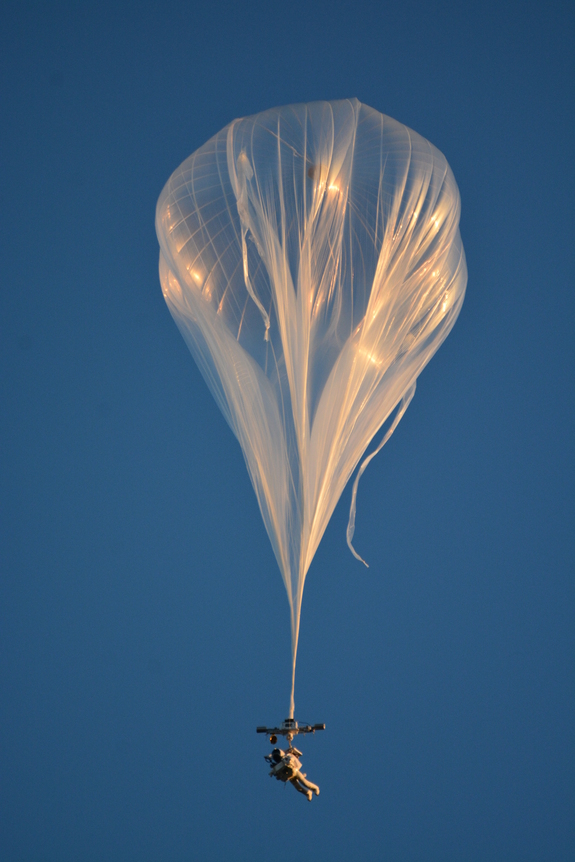Skydiver Goes Supersonic in Record-Breaking 'Near-Space Dive'
In a harrowing plunge from the stratosphere, a Google executive broke the world record for the highest-altitude skydive today (Oct. 24).
Alan Eustace, a senior vice president at Google, hit supersonic speeds as he fell from more than 25 miles (40 kilometers) above New Mexico, smashing the altitude record that Austrian daredevil Felix Baumgartner set two years ago with his famous Red Bull Stratos "space jump." Eustace's epic feat was orchestrated by the Stratospheric Explorer (StratEx) team at the Paragon Space Development Corporation.
Wearing a custom-made pressurized spacesuit, Eustace was lifted into the air this morning by a high-altitude, helium-filled scientific balloon. After a trip that lasted 2 hours and 9 minutes, he cut himself loose at an unprecedented altitude of 135,890 feet (41,419 meters). He reached a speed of 822 mph (1,322 km/h). That sent Eustace through the sound barrier, and he reached Mach 1.23 at his fastest speed. Eustace's body set off a sonic boom that could be heard by the recovery team on the ground, said Grant Anderson, CEO of Paragon. [See more amazing photos of StratEx's near-space dive]
Baumgartner set the previous record on Oct. 14, 2012, when he stepped out of a specially built capsule that was lifted by a balloon 128,000 feet (39,000 m) above Earth. Eustace didn't ride inside any kind of pod, but was instead attached to the balloon directly. He was only protected from the harsh environment outside by his spacesuit, made by ILC Dover, a company known for making spacesuits for NASA astronauts.
Eustace, 57, was already an experienced skydiver and pilot when he came to Paragon, Anderson said, but he required extra training and had to complete a series of increasingly difficult test dives before today's feat. Eustace also had to learn how to move around in his high-tech pressure suit, which weighs some 400 lbs. (181 kilograms)
"It's not a suit you would wear to walk your dog around the block," Anderson said.
The team decided against using a capsule because it would have presented additional problems — more weight for the balloon to carry and two life-support systems.
Breaking space news, the latest updates on rocket launches, skywatching events and more!
"Designing a suit that would just keep him alive and comfortable for the whole period of time seemed like a simpler way to do it," Anderson told Space.com.
Eustace remained in free fall for approximately 4.5 minutes before deploying his parachute, according to Paragon representatives. During that time, he became the second person ever to break the sound barrier outside an aircraft. (Baumgartner was the first.) After another 14 minutes spent drifting back to Earth's surface by parachute, Eustace safely tumbled to the ground about 70 miles (113 km) from his launch point in Roswell, New Mexico. Anderson told Space.com that the skydiver was "in perfect shape."
Eustace also set the world record for free fall under a drogue chute, as well as national records for highest exit altitude and vertical speed, according to Paragon representatives.
"I always wondered: what if you could design a system that would allow humans to explore the stratosphere as easily and safely as they do the ocean?" Eustace said in a statement. "With the help of the world-class StratEx team, I hope we've encouraged others to explore this part of the world about which we still know so little."
The dive from the stratosphere required 34 months of preparation by Paragon and its StratEx team, which developed the balloon, spacesuit and accompanying support systems.
One of Paragon's co-founders, Jane Poynter, is CEO of World View, a company that hopes to take paying customers on balloon rides to near-space inside of a sealed capsule.
Editor's Note: This article was updated at 5:52 p.m. EDT to add comments from Grant Anderson.
Follow Megan Gannon on Twitter and Google+. Follow us @SPACEdotcom, Facebook or Google+. Originally published on Space.com.
Join our Space Forums to keep talking space on the latest missions, night sky and more! And if you have a news tip, correction or comment, let us know at: community@space.com.

Megan has been writing for Live Science and Space.com since 2012. Her interests range from archaeology to space exploration, and she has a bachelor's degree in English and art history from New York University. Megan spent two years as a reporter on the national desk at NewsCore. She has watched dinosaur auctions, witnessed rocket launches, licked ancient pottery sherds in Cyprus and flown in zero gravity on a Zero Gravity Corp. to follow students sparking weightless fires for science. Follow her on Twitter for her latest project.


